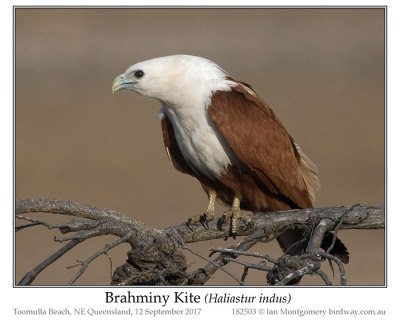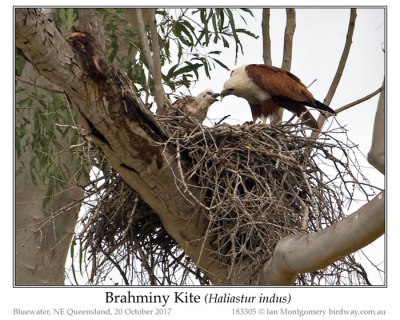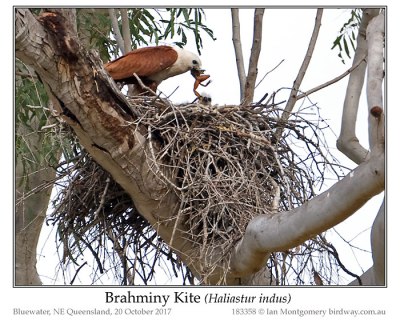Surprise, surprise – another bird of the moment at last. The Brahminy Kite last featured as bird of the week in August 2003. In those days you got a single photo and a short paragraph of text, so here is a more thorough treatment. This is one of my favourite Australian raptors and the adults are striking looking birds with their white and chestnut plumage. They’re a common sight along the coast here in North Queensland, and the bird in the first two photos was photographed at Toomulla Beach, about 40km northwest of Townsville and not far from where I live in Bluewater.
The hooked beak is like that of the White-bellied Sea-Eagle, so it’s no surprise that they are adapted to eating fish, for which they both hunt and scavenge and are usually found near water, mainly coastal but also along larger rivers. They have, however, very broad tastes and will eat any flesh that they can catch or find, both vertebrate and invertebrate. It’s not unusual to see them cruising main roads looking for road-kill. With a length of about 50cm/20in and a wingspan of 1.2m/47in , they’re much smaller than sea-eagles (80cm/31in and 1.8-2.2m/71-87in), but their preferred habitat and diet means that they’re are often called sea-eagles by the general population.
The names “Brahminy” and Haliastur indus give a clue as to their geographical range, as they were first described in India. Their range extends from Pakistan in the west through south and southwest Asia to eastern China and Taiwan, and south through the Philippines, Malaysia and Indonesia to New Guinea and Australia. In Australia its range is mainly tropical from Carnarvon in Western Australia across northern Australia and down the east coast as far as about Myall Lakes in New South Wales, though it is uncommon south of Cape Byron. Its population in New South Wales contracted northwards owing to the use of persistent organochloride insecticides in the third quarter of the 20th century, but there is some evidence of recovery since then.
Immature birds differ greatly in appearance from the adults, third photo, and are easily confused with other raptors such as, in Australia, pale phase Little Eagles or immature Black-breasted Buzzards. Immature birds are also rather similar to their only close relative the Whistling Kite (Haliastur sphenurus), though Brahminy Kites have much shorter, rather eagle-like tails and shorter wings.
You may remember that I visited Slovakia in June 2016 with my sister Gillian. The main birding target was eagles, but despite the best efforts of our guides we had only limited success with such species as Lesser Spotted Eagle Eastern Imperial Eagle and Golden Eagle, and the local raptors didn’t seem at all keen on having their photos taken. So, there was a certain irony when I returned to Bluewater and found that my excellent house minders, Julie and Ed, had discovered a pair of Brahminy Kites nesting in my neighbour’s property, about 100m from my house (fifth photo). The grass is greener, etc. etc.
The birds attended the nest for about three months but disappointingly without success. The nest was high up, about 25m/80ft from the ground, so it wasn’t possible to see into it, so I don’t know what happened. Anyway, you can understand my delight when the birds returned again this year and restored the nest, sixth photo.
At the beginning of last week I finally spotted a healthy looking chick. It survived the unseasonable heavy rain we had last week (150mm/6in in five days) so I set up the camera and tripod, table, chair and coffee near the house and watched them in comfort at an unobtrusive distance for most of Friday afternoon. Sure enough, both adults arrived with food. The first, seventh photo, produced a flying fox (fruit bat), a Black Flying-fox I think, and spent an hour carefully tearing off tiny strips of muscle and feeding to the chick.
I was impressed with the gentle way the parent fed the youngster and itself. Eventually, the chick seemed satisfied, and lost interest in the meal. The adult bird slipped away as quietly as it had arrived – I didn’t see it leave – and I presume it took the remains of the fruit bat with it.
Within half an hour, the other adult arrived with a frog, I think a Green Tree Frog (ninth photo). This adult has whiter plumage and a longer beak than its partner, so they are not hard to distinguish.
The chick seemed satiated and not very interested, so the adult hungrily ate some of the frog itself and after a little while flew off taking the frog with it and went down to nearby Bluewater Creek.
Brahminy Kites usually lay 2 or 3 eggs, and often only one chick survives to fledging. Incubation takes about 35 days, and fledging 7 to 8 weeks. The young birds remain dependent on the adults for a further two months. This chick is about half the length of the adults and is beginning to grow proper feathers, including flight feathers on the wings, though these currently appear as just short quills.
I can see the nest through the trees from my back verandah, so it is easy to check on it. I plan to photograph progress over the coming weeks. A furry mammal, probably road-kill, was on the menu today.
Greetings
Ian
Fantastic photos of the Brahminy Kite. It sure has been a while since Ian had a “Moment” to share another of his interesting post with us. Thanks, Ian. We always enjoy seeing and learning about your birds.
For more of Ian’s Bird of the Week – Moments
“And the vulture, and the kite after his kind;” (Leviticus 11:14 KJV)
“Then God said, “Let the waters abound with an abundance of living creatures, and let birds fly above the earth across the face of the firmament of the heavens.” (Genesis 1:20 NKJV)
Accipitridae – Kites, Hawks & Eagles Family
Birds of the Bible – Gledes and Kites
*









